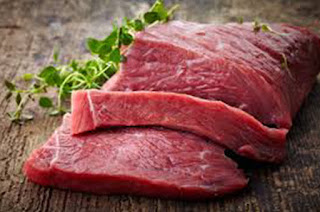
Beef refers to cattle meat, which includes cows, steers, heifers, calves, and bulls. It is classified according to where it is extracted from the animal. Beef can be prepared as steak, roasts, ribs, or hamburger ground. When an animal is processed as beef, it is estimated that 98% of the animal is used, resulting in little waste. While only 45% is used to make beef, the remainder is used to make leather, glue, soap, gelatin, insulin, and pharmaceutical drugs. According to estimates, every adult American consumes at least 65 pounds of beef per year.
Cattle descended from the aurochs, a wild animal that originated in India and spread throughout the world.
Aurochs were domesticated in Europe around 10,000 years ago.
Domestication began with pigs, sheep, dogs, and goats before the aurochs.
Aurochs can be seen in French cave paintings.
A cow is an adult female who has had at least one calf.
A male animal is a bull.
A steer is a male animal that has been rendered incapable of reproducing.
A heifer is a female who has not yet given birth to a calf.
Veal refers to calves that are raised to weigh between 475 and 500 pounds.
Cattle were previously raised for labor as well as for meat and byproducts.
Cattle are raised all over the world, often in areas that are unsuitable for farming due to the terrain.
Filet mignon, sirloin steak, rump steak, and rib eye steak are all popular beef steaks.
Beef can be labeled as Certified Angus Beef, Certified Hereford Beef, Grass-fed Beef, Kobe Beef, Kosher Beef, or Organic Beef.
Beef can be graded according to quality in the United States, as U.S. Prime, United States Choice, United States Select, United States Standard, United States Commercial, United States Utility, United States Cutter, and United States Canner.
Grilling, barbecuing, broiling, griddling, roasting, frying, dehydrated, braised, stewed, sous-vide, smoked, cured, or corned are all ways to prepare beef.
Beef is sometimes consumed raw, as in steak tartare, a French dish, or filet americain, a Belgian dish, or kibbeh nayyeh, a Lebanese dish.
Pastrami, beef jerky, biltong, bresaola, and spiced beef can all be made from beef.
The Hindu religion considers cattle slaughter and beef consumption to be sinful. They place a high value on the cow’s milk.
Red meat consumption has been linked to a variety of health issues, including cancer, cardiovascular disease, coronary artery disease, and mad cow disease.
Beef product recalls are common due to E. coli contamination. Coli. In humans, contamination and infection can be fatal.
Cattle have a single stomach divided into four compartments. They can now consume and digest grasses because of this.
Each year, cattle farming produces approximately 25 billion pounds of beef.
Beef is the third most popular meat consumed by humans worldwide, trailing only pork and poultry.
Cattle farms are thought to contribute to greenhouse gas emissions and have a negative impact on the global environment.
Beef FAQs
Beef is a popular source of protein around the world, but there’s a lot to know about it! Here are some of the most commonly asked questions:
1. What is beef?
Beef is the meat from cattle (Bos taurus). It’s a red meat, meaning it has a higher myoglobin content than white meat like chicken or fish. Myoglobin is a protein that stores oxygen in muscles, contributing to the red color and richer flavor of beef.
2. What are the different cuts of beef?
There are many different cuts of beef, each with its own unique characteristics and ideal cooking methods. Here’s a brief breakdown:
- Primals: These are the large, primary cuts from a whole cow, like the chuck, rib, loin, round, flank, and plate.
- Subprimals: These are smaller sections cut from the primals, such as ribeye, tenderloin, strip steak, brisket, short rib, and ground beef.
3. What’s the difference between grain-fed and grass-fed beef?
- Grain-fed beef: These cattle are typically raised in feedlots and finished on a diet rich in grains like corn. This diet promotes marbling (fat deposits within the muscle) which contributes to tenderness and flavor. Grain-fed beef is generally considered more tender and juicy.
- Grass-fed beef: As the name suggests, these cattle are raised primarily on grass pastures. Grass-fed beef tends to be leaner with less marbling, but it may be higher in certain nutrients like omega-3 fatty acids. Some people also prefer the flavor profile of grass-fed beef.
4. Is beef healthy?
Beef can be a healthy part of a balanced diet, but it depends on the cut, portion size, and overall dietary habits. Here’s a breakdown of the nutritional content:
- Rich in protein: Beef is an excellent source of high-quality protein, essential for building and repairing tissues.
- Iron and zinc: Beef is a good source of iron, which helps carry oxygen in the blood, and zinc, important for immune function and wound healing.
- Saturated fat: Beef, particularly fattier cuts, can be high in saturated fat. Consuming too much saturated fat is linked to an increased risk of heart disease.
Tips for healthy beef consumption:
- Choose leaner cuts of beef, like sirloin, flank steak, or top round.
- Trim away excess visible fat before cooking.
- Use healthy cooking methods like grilling, broiling, or baking instead of frying.
- Practice portion control. A serving of cooked beef is typically around 3-4 ounces, about the size of a deck of cards.
5. What are some common questions about beef safety?
- How to store beef: Fresh beef should be stored in the refrigerator for 3-5 days or frozen for up to a year. Ground beef should only be stored in the refrigerator for 1-2 days.
- Safe internal cooking temperature: The USDA recommends a safe minimum internal temperature of 145°F (63°C) for whole cuts of beef and 160°F (71°C) for ground beef to ensure proper cooking and eliminate harmful bacteria.
6. Where can I learn more about beef?
Here are some reputable sources for more information about beef:
- USDA Beef & Veal: https://www.ams.usda.gov/grades-standards/beef
- National Cattlemen’s Beef Association: https://www.ncba.org/
These resources offer information about the different cuts of beef, cooking methods, safety tips, and the nutritional value of beef.










Hey there! I wanted to drop a note to say how much I enjoyed reading your post. Your insights on this topic were really thought-provoking, and I appreciate the time and effort you put into your writing. Looking forward to more!